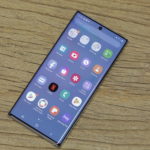The five technical challenges Cerebras overcame in building the first trillion transistor chip
Superlatives abound at Cerebras, the until-today stealthy next-generation silicon chip company looking to make training a deep learning model as quick as buying toothpaste from Amazon. Launching after almost three years of quiet development, Cerebras introduced its new chip today — and it is a doozy. The “Wafer Scale Engine” is 1.2 trillion transistors (the most ever), 46,225 square millimeters (the largest ever), and includes 18 gigabytes of on-chip memory (the most of any chip on the market today) and 400,000 processing cores (guess the superlative).
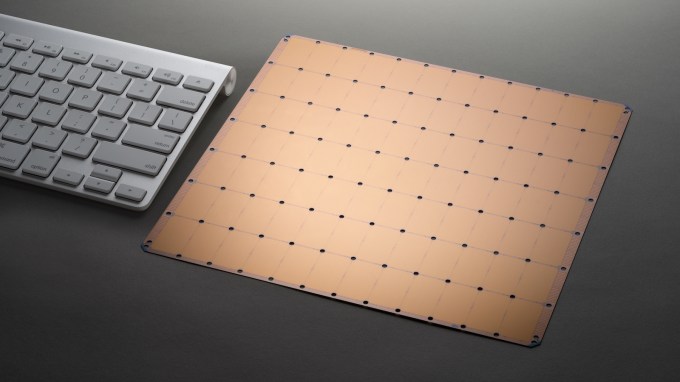
Cerebras’ Wafer Scale Engine is larger than a typical Mac keyboard (via Cerebras Systems)
It’s made a big splash here at Stanford University at the Hot Chips conference, one of the silicon industry’s big confabs for product introductions and roadmaps, with various levels of oohs and aahs among attendees. You can read more about the chip from Tiernan Ray at Fortune and read the white paper from Cerebras itself.
Superlatives aside though, the technical challenges that Cerebras had to overcome to reach this milestone I think is the more interesting story here. I sat down with founder and CEO Andrew Feldman this afternoon to discuss what his 173 engineers have been building quietly just down the street here these past few years with $112 million in venture capital funding from Benchmark and others.
Going big means nothing but challenges
First, a quick background on how the chips that power your phones and computers get made. Fabs like TSMC take standard-sized silicon wafers and divide them into individual chips by using light to etch the transistors into the chip. Wafers are circles and chips are squares, and so there is some basic geometry involved in subdividing that circle into a clear array of individual chips.
One big challenge in this lithography process is that errors can creep into the manufacturing process, requiring extensive testing to verify quality and forcing fabs to throw away poorly performing chips. The smaller and more compact the chip, the less likely any individual chip will be inoperative, and the higher the yield for the fab. Higher yield equals higher profits.
Cerebras throws out the idea of etching a bunch of individual chips onto a single wafer in lieu of just using the whole wafer itself as one gigantic chip. That allows all of those individual cores to connect with one another directly — vastly speeding up the critical feedback loops used in deep learning algorithms — but comes at the cost of huge manufacturing and design challenges to create and manage these chips.
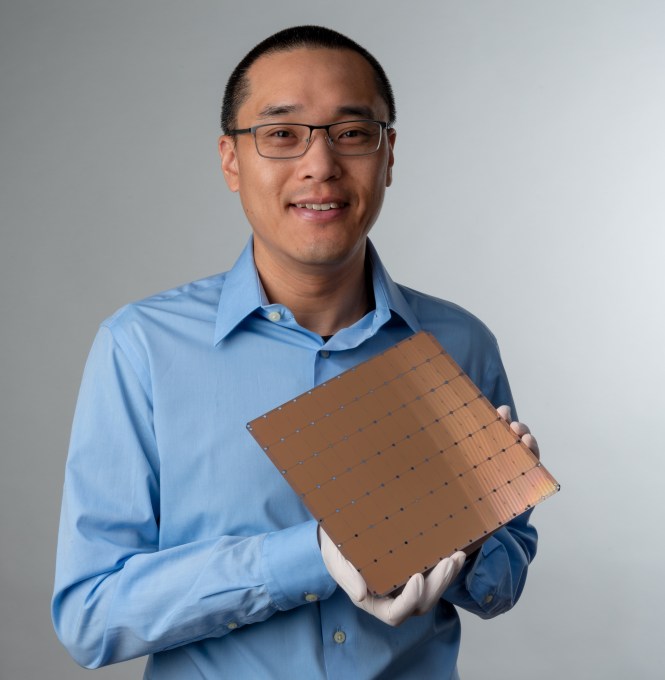
Cerebras’ technical architecture and design was led by co-founder Sean Lie. Feldman and Lie worked together on a previous startup called SeaMicro, which sold to AMD in 2012 for $334 million. (Via Cerebras Systems)
The first challenge the team ran into according to Feldman was handling communication across the “scribe lines.” While Cerebras chip encompasses a full wafer, today’s lithography equipment still has to act like there are individual chips being etched into the silicon wafer. So the company had to invent new techniques to allow each of those individual chips to communicate with each other across the whole wafer. Working with TSMC, they not only invented new channels for communication, but also had to write new software to handle chips with trillion plus transistors.
The second challenge was yield. With a chip covering an entire silicon wafer, a single imperfection in the etching of that wafer could render the entire chip inoperative. This has been the block for decades on whole wafer technology: due to the laws of physics, it is essentially impossible to etch a trillion transistors with perfect accuracy repeatedly.
Cerebras approached the problem using redundancy by adding extra cores throughout the chip that would be used as backup in the event that an error appeared in that core’s neighborhood on the wafer. “You have to hold only 1%, 1.5% of these guys aside,” Feldman explained to me. Leaving extra cores allows the chip to essentially self-heal, routing around the lithography error and making a whole wafer silicon chip viable.
Entering uncharted territory in chip design
Those first two challenges — communicating across the scribe lines between chips and handling yield — have flummoxed chip designers studying whole wafer chips for decades. But they were known problems, and Feldman said that they were actually easier to solve that expected by re-approaching them using modern tools.
He likens the challenge though to climbing Mount Everest. “It’s like the first set of guys failed to climb Mount Everest, they said, ‘Shit, that first part is really hard.’ And then the next set came along and said ‘That shit was nothing. That last hundred yards, that’s a problem.’”
And indeed, the toughest challenges according to Feldman for Cerebras were the next three, since no other chip designer had gotten past the scribe line communication and yield challenges to actually find what happened next.
The third challenge Cerebras confronted was handling thermal expansion. Chips get extremely hot in operation, but different materials expand at different rates. That means the connectors tethering a chip to its motherboard also need to thermally expand at precisely the same rate lest cracks develop between the two.
Feldman said that “How do you get a connector that can withstand [that]? Nobody had ever done that before, [and so] we had to invent a material. So we have PhDs in material science, [and] we had to invent a material that could absorb some of that difference.”
Once a chip is manufactured, it needs to be tested and packaged for shipment to original equipment manufacturers (OEMs) who add the chips into the products used by end customers (whether data centers or consumer laptops). There is a challenge though: absolutely nothing on the market is designed to handle a whole-wafer chip.
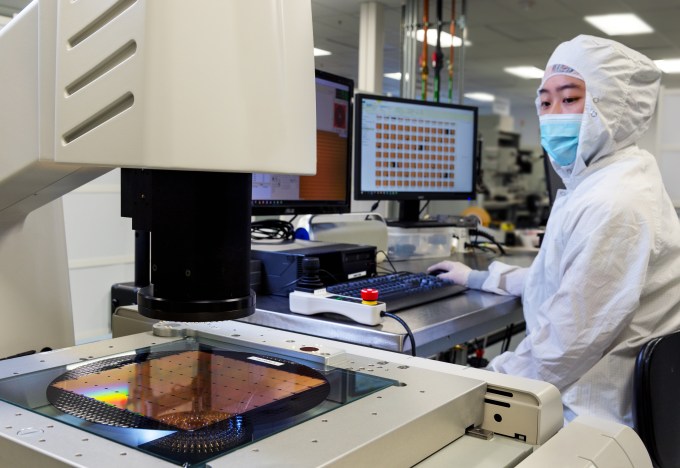
Cerebras designed its own testing and packaging system to handle its chip (Via Cerebras Systems)
“How on earth do you package it? Well, the answer is you invent a lot of shit. That is the truth. Nobody had a printed circuit board this size. Nobody had connectors. Nobody had a cold plate. Nobody had tools. Nobody had tools to align them. Nobody had tools to handle them. Nobody had any software to test,” Feldman explained. “And so we have designed this whole manufacturing flow, because nobody has ever done it.” Cerebras’ technology is much more than just the chip it sells — it also includes all of the associated machinery required to actually manufacture and package those chips.
Finally, all that processing power in one chip requires immense power and cooling. Cerebras’ chip uses 15 kilowatts of power to operate — a prodigious amount of power for an individual chip, although relatively comparable to a modern-sized AI cluster. All that power also needs to be cooled, and Cerebras had to design a new way to deliver both for such a large chip.
It essentially approached the problem by turning the chip on its side, in what Feldman called “using the Z-dimension.” The idea was that rather than trying to move power and cooling horizontally across the chip as is traditional, power and cooling are delivered vertically at all points across the chip, ensuring even and consistent access to both.
And so, those were the next three challenges — thermal expansion, packaging, and power/cooling — that the company has worked around-the-clock to deliver these past few years.
From theory to reality
Cerebras has a demo chip (I saw one, and yes, it is roughly the size of my head), and it has started to deliver prototypes to customers according to reports. The big challenge though as with all new chips is scaling production to meet customer demand.
For Cerebras, the situation is a bit unusual. Since it places so much computing power on one wafer, customers don’t necessarily need to buy dozens or hundreds of chips and stitch them together to create a compute cluster. Instead, they may only need a handful of Cerebras chips for their deep-learning needs. The company’s next major phase is to reach scale and ensure a steady delivery of its chips, which it packages as a whole system “appliance” that also includes its proprietary cooling technology.
Expect to hear more details of Cerebras technology in the coming months, particularly as the fight over the future of deep learning processing workflows continues to heat up.
Powered by WPeMatico
YC’s latest VR bet is a team building a cyberpunk anime MMO
There are niche startups and then there are VR companies going after fans of the “cyberpunk fantasy anime aesthetic.”
Ramen VR is one of only a few virtual reality startups that Y Combinator has bet on in the past few years and is only one of two in the company’s most recent batch of bets. It has a niche approach, but it’s hoping to build an MMO that can leanly grow alongside the slow-but-steady virtual reality market. Like any content play that’s hoping for VC dollars, Ramen VR wants eventually to be a platform.
“Long-term, our goal isn’t just to create a game, but we’ve seen the issues of VR platforms that tried to be platforms before they had a meaningful use case. If you’re just trying to be a chat room or platform without any users, that doesn’t work,” CEO Andy Tsen tells TechCrunch.
The company’s first title is called Zenith, and it’s an anime-inspired fantasy title that plays with cyberpunk themes as well. The founders are really aiming to give VR geeks the game that they want, one that taps into the 80s futuristic aesthetic with gameplay that pays tribute to popular sci-fi books, movies and games of the era.
MMOs are attracting quite a bit of inbound interest in the venture-backed startup world. Part of the reasoning has been because of people seeing the scope a title like Fortnite was able to achieve so quickly after going virall; the other part is the prevalence of developer tools that gaming startups are able to easily plug into their tech stacks. Ramen VR is using Improbable’s SpatialOS to bring persistent online gameplay to its users.
The company just rolled out a Kickstarter to gauge interest for Zenith; they launched a week ago and have raised $132,000 in the crowdfunding campaign thus far. Backers get access to a VR version of the title as well as a desktop PC copy. The startup plans to roll out across VR devices, including PC systems, PlayStation VR and Oculus Quest.
“The whole point is that it’s not just on one device, it’s a world, it’s literally the Upside Down from Stranger Things layered on top of your entire world. At any point, no matter what screen you’re on, you can access that,” CTO Lauren Frazier tells us.
The startup still has a bit of development ahead of them, but the current plan is to launch an Alpha in six months, a beta in nine months and to go live broadly a year from now.
Powered by WPeMatico
Mammoth Media introduces Choose Your Own Adventure-style storytelling to its chat fiction app Yarn
The chat fiction stories offered in Mammoth Media‘s mobile app Yarn are about to get more interactive.
The branching narrative mechanic should be familiar to anyone who read Choose Your Own Adventure books when they were kids — you read a story, and, at certain key moments, you choose from different options that determine where the plot will go next.
More recently, the “Being Beyonce’s assistant for a day” thread on Twitter reminded everyone how fun and stressful this kind of storytelling can be. In fact, Mammoth says it’s hired the thread’s author Landon Rivera as one of the writers for this new initiative.
One thing you probably won’t recognize from your childhood reading is the fact that some of these choices aren’t free — to select them, you’ll need to spend money in the form of Yarn’s new virtual currency, gems.
Mammoth founder and CEO Benoit Vatere explained that in those cases, there might be two choices that you can select for free, plus a third that you need to pay for. Usually, it will be something that accelerates the story or sends it off in a new direction — in a horror story, you could get the option to stab someone, or in a romance story, your character could get the option to go home with someone.
Vatere added, “It’s not only being able to have a different branch in the story, but being able to play as a different character lead … Instead of being the male character, would they like to be the female character and really see a different perspective?”
He acknowledged that some of Yarn’s paying subscribers might be cranky about being asked to pay more, but he said the goal is that those subscribers can have “a full experience” without having to buy additional gems.
Yarn is launching interactive stories with titles including “Blue Ivy’s Nanny,” where it’s your first day on the job as Beyoncé’s nanny (I’m going to go ahead and guess that Rivera worked on this one); a romance story called “Playing the Field;” a horror story called “Haunted Camper” and a drama called “Trapped.” Vatere also said there are plans for branched narratives tying into existing Yarn franchises, and set in the world of Archie Comics.
Overall, Vatere said he’s hoping that this will lead to more engagement from Yarn readers, while also opening up new opportunities for monetization.
“Subscription is a great model, but subscription has a cap,” he said. That’s why Mammoth is experimenting with virtual currency, and why it plans to make these stories available to non-subscribers.
Powered by WPeMatico
These are the games coming to Google Stadia
Google’s game streaming service isn’t set to launch until November, but the company kept the hype train going through the mid-August doldrums with a Gamescom Stadia Connect live stream. As promised, the online press conference was “all about the games,” featuring what looks to be a nearly complete list of launch (and some post-launch) titles.
The games include some top names, like Cyberpunk 2077, Final Fantasy XV, Assassin’s Creed Odyssey and Mortal Kombat 11. It also enlists a number of top publishers, including Bethesda, Square and Ubisoft. A number of key publishing partners have opted to keep their lists under wraps until closer to (or at) launch, however, including EA, Capcom and Rockstar.
As previously noted, the service will run $10 a month, including access to games and discounts on purchases. A base version of the service will also be available at some point next year. When it launches in November, the service will be available in 14 countries, including the U.S., Canada, the U.K., Ireland, France, Germany, Italy, Spain, the Netherlands and Finland. More will be added in 2020.
Google is currently offering up a “Founder’s Edition” pre-order for $130. That includes a controller, Chromecast Ultra and three months of the service for you and a friend.
Here’s the list of titles so far:
- Bandai Namco – Dragon Ball Xenoverse 2
- Bethesda – DOOM Eternal, DOOM 2016, Rage 2, The Elder Scrolls Online, Wolfenstein: Youngblood
- Bungie – Destiny 2, Destiny 2: Shadowkeep Expansion
- CD PROJEKT RED – Cyberpunk 2077
- Chump Squad – KINE
- Coatsink – Get Packed
- Codemasters – GRID
- Dotemu – Windjammers 2
- Deep Silver – Metro Exodus
- Drool – Thumper
- Giants Software – Farming Simulator 19
- Larian Studios – Baldur’s Gate 3
- nWay Games – Power Rangers: Battle for the Grid
- Omega Force – Attack on Titan 2: Final Battle
- Pandemic Studios – Destroy All Humans!
- Robot Entertainment – Orcs Must Die 3
- Sega – Football Manager
- SNK – Samurai Shodown
- Square Enix – Final Fantasy XV – Tomb Raider Definitive Edition, Rise of the Tomb Raider, Shadow of the Tomb Raider, Marvel’s Avengers
- SUPERHOT – SUPERHOT
- 2K – NBA 2K, Borderlands 3
- Tequila Works – Gylt
- Warner Bros – Mortal Kombat 11
- THQ – Darksiders Genesis
- Ubisoft – Assassin’s Creed Odyssey, Just Dance , Tom Clancy’s Ghost Recon Breakpoint, Tom Clancy’s The Division 2 , Trials Rising, The Crew 2, Watch Dogs: Legion
Powered by WPeMatico
Shell’s first Greenlots electric vehicle fast charger lands in Singapore
Royal Dutch Shell, the energy giant known for its fossil fuel production and hundreds of Shell gas stations, is creeping into the electric vehicle-power business.
The company’s first DC fast charger from its newly acquired company Greenlots launched Monday at a Shell gas station in Singapore. Greenlots, an EV charging startup acquired by Shell in January, installed the charger. This is the first of 10 DC fast chargers that Greenlots plans to bring to Shell service stations in Singapore over the next several months.
The decision to target Singapore is part of Greenlots’ broader strategy to provide EV charging solutions across all applications throughout Asia and North America, the company said. Both Shell and Greenlots have a presence in Singapore. Greenlots, which is based in Los Angeles, was founded in Singapore; and Shell is one of Singapore’s largest foreign investors.
Singapore has been promoting the use of electric vehicles, particularly for car-sharing and ride-hailing platforms. The island city-state has been building up its EV infrastructure to meet anticipated demand as ride-hailing drivers and commercial fleets switch to electric vehicles.
Greenlots was backed by Energy Impact Partners, a cleantech investment firm, before it was acquired by Shell. The company, which combines its management software with the EV charging hardware, has landed some significant customers in recent years, notably Volkswagen. Greenlots is the sole software provider to Electrify America, the entity set up by Volkswagen as part of its settlement with U.S. regulators over its diesel emissions cheating scandal.
Clarification: Shell has other EV chargers. These are the first through its newly acquired company Greenlots.
Powered by WPeMatico
YouTube Originals become ad-supported and free after September 24th
In an email distributed to YouTube Premium subscribers, the company confirmed that access to YouTube’s original programming will no longer be exclusive to Premium customers after September 24th, 2019. Instead, many of YouTube’s Originals series, movies and live events will be offered to all YouTube viewers for free, supported by ads. Premium members, however, can watch the content ad-free.
In addition, Premium subscribers will have access to all the available episodes in a series right when they premiere, says YouTube, and they’ll be able to download them for offline viewing.
There will also continue to be some exclusive subscriber-only content, in the form of things like director’s cuts and extra scenes from YouTube Originals.
YouTube previously announced its plans to make its original programming available for free, following a larger shift in strategy for the video platform. According to a Deadline report from last November, YouTube had been reassessing its scripted development plans with a goal of refocusing on unscripted shows and specials. It also stopped taking new scripted pitches.
The company found some success with scripted content, the report noted — like Cobra Kai, which at the time had 100 million views and a 100% Rotten Tomatoes score. But the company was also finding success with celebrity content, like Katy Perry: Will You Be My Witness and Will Smith’s Grand Canyon bungee stunt, for example.
This is the direction YouTube may be aiming to pursue next, Deadline said.
Perhaps not coincidentally, Variety recently reported on a new crowdfunding service for YouTube creators, Fundo, which allows start to invite fans to virtual meet & greet sessions and other paid online events. However, this project is not from YouTube or Google itself, but rather its in-house incubator, Area 120, which operates more independently. That said, it reflects YouTube’s larger interest in the creation of new revenue streams for creators beyond ads and subscriptions.
Along with the news of the changes to YouTube Originals, the email to Premium subscribers also alerted them to the addition of a “Recommended Downloads” feature on the Library tab, which lets them browse and download videos from YouTube’s algorithmic suggestions. And it noted YouTube Music changes, like the ability to switch between video and audio and the launch of “smart downloads,” which automatically download up to 500 songs from Liked Songs and other favorite playlists and albums.
Powered by WPeMatico
Minecraft to get big lighting, shadow and color upgrades through Nvidia ray tracing
Minecraft is getting a free update that brings much-improved lighting and color to the game’s blocky graphics using real-time ray tracing running on Nvidia GeForce RTX graphics hardware. The new look is a dramatic change in the atmospherics of the game, and manages to be eerily realistic while retaining Minecraft’s pixelated charm.
The ray-tracing tech will be available via a free update to the game on Windows 10 PCs, but it’ll only be accessible to players using an Nvidia GeForce RTX GPU, as that’s the only graphics hardware on the market that currently supports playing games with real-time ray tracing active.
It sounds like it’ll be an excellent addition to the experience for players who are equipped with the right hardware — including lighting effects not only from the sun, but also from in-game materials like glowstone and lava; both hard and soft shadows depending on transparency of material and angle of light refraction; and accurate reflections in surfaces that are supposed to be reflective (i.e. gold blocks, for instance).
This is welcome news after Minecraft developer Mojang announced last week that it canceled plans to release its Super Duper Graphics Pack, which was going to add a bunch of improved visuals to the game because it wouldn’t work well across platforms. At the time, Mojang said it would be sharing news about graphics optimization for some platforms “very soon,” and it looks like this is what they had in mind.
Nvidia, meanwhile, is showing off at Gamescom 2019 in Cologne, Germany a range of 2019 games with real-time ray tracing enabled, including Dying Light 2, Cyperpunk 2077, Call of Duty: Modern Warfare and Watch Dogs: Legion.
Powered by WPeMatico
Startups Weekly: The mad dash to the public markets
Hello and welcome back to Startups Weekly, a weekend newsletter that dives into the week’s noteworthy startups and venture capital news. Before I jump into today’s topic, let’s catch up a bit. Last week, I wrote about the differences between raising cash from angels and traditional venture capitalists. Before that, I summarized DoorDash’s acquisition of Caviar.
Remember, you can send me tips, suggestions and feedback to kate.clark@techcrunch.com or on Twitter @KateClarkTweets. If you don’t subscribe to Startups Weekly yet, you can do that here.
It’s Friday morning and I don’t want to dig into another IPO prospectus. The startups don’t care though, they’re in a mad dash to get to the public markets, reporters be damned.
This week, three billion-dollar venture-backed “unicorns” unveiled S-1 filings, the paperwork necessary to complete an IPO. First came WeWork, the $47 billion co-working giant beloved by SoftBank. Then came Cloudflare, a business that provides web security and denial-of-service protection for websites. Then this morning, after we all thought it was time for a breather, “teledentistry” company SmileDirectClub made its filing public.
There’s plenty to read on each of these high-profile IPOs; here’s a quick reading list:
WeWork
WeWork reveals IPO filing
WeWork’s S-1 misses these three key points
Making sense of WeWork’s S-1 (or trying to)
Cloudflare
Cloudflare files for initial public offering
Cloudflare says cutting off customers like 8chan is an IPO ‘risk factor’
In its IPO filing, Cloudflare thanks a third co-founder: Lee Holloway
SmileDirectClub
SmileDirectClub files to go public amid concerns from dental associations
On to other things…

Meet the startups in Y Combinator’s summer batch
As you may know, YC summer demo days are next week. A whopping 176 companies are expected to present and we’ll be there reporting live, as usual. In preparation, we’ve been cherry-picking companies in the latest batch that interest us. Here’s a look at our latest — more to come:
- Narrator wants to become the operating system for data science
- This startup is building a weed breathalyzer for cops
- Lokal wants to bring local news to 900M Indians in their regional languages
- Holy Grail is using machine learning to build better batteries
- Shiru is developing a protein replacement for food additives
- Lumineye helps first responders identify people through walls
- GradJoy is a fintech startup to help you knock out your student loans
- Traces AI is creating a less invasive alternative to facial recognition tracking
Equity Podcast
This was a very special week for Equity. We taped two great episodes, one in which we hung out with Axios’ Dan Primack in Boston, the other featuring me recording out of a New York City Blue Bottle Coffee shortly after WeWork dropped its S-1 filing. You can listen to our latest episodes here and here. Equity drops every Friday at 6:00 am PT, so subscribe to us on Apple Podcasts or Spotify.
Extra Crunch
In our latest installment of EC-1, in which go deep on an up-and-coming startup, TechCrunch’s Eric Peckham tells the founding story of Kobalt, the world’s next music tech unicorn. Here’s a passage from Peckham’s extensive piece: “You may not have heard of Kobalt before, but you probably engage with the music it oversees every day, if not almost every hour. Combining a technology platform to better track ownership rights and royalties of songs with a new approach to representing musicians in their careers, Kobalt has risen from the ashes of the 2000 dot-com bubble to become a major player in the streaming music era. It is the leading alternative to incumbent music publishers (who represent songwriters) and is building a new model record label for the growing ‘middle class’ of musicians around the world who are stars within niche audiences.”
Powered by WPeMatico
Samsung Galaxy Note 10+ review
It’s true, you’ve got the Galaxy Note to thank for your big phone. When the device hit the scene at IFA 2011, large screens were still a punchline. That same year, Steve Jobs famously joked about phones with screens larger than four inches, telling a crowd of reporters, “nobody’s going to buy that.”
In 2019, the average screen size hovers around 5.5 inches. That’s a touch larger than the original Note’s 5.3 inches — a size that was pretty widely mocked by much of the industry press at the time. Of course, much of the mainstreaming of larger phones comes courtesy of a much improved screen to body ratio, another place where Samsung has continued to lead the way.
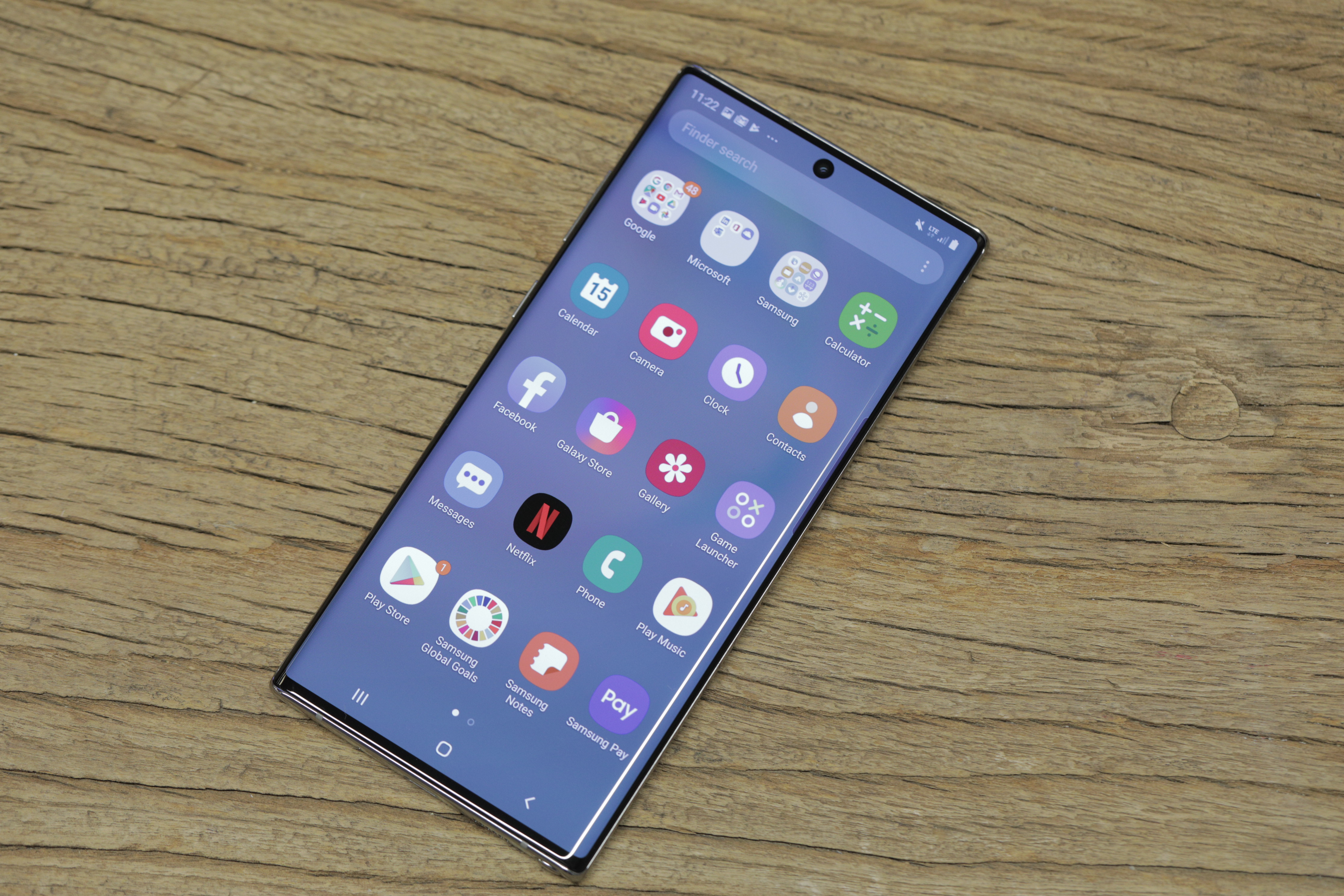
In some sense, the Note has been doomed by its own success. As the rest of the industry caught up, the line blended into the background. Samsung didn’t do the product any favors by dropping the pretense of distinction between the Note and its Galaxy S line.
Ultimately, the two products served as an opportunity to have a six-month refresh cycle for its flagships. Samsung, of course, has been hit with the same sort of malaise as the rest of the industry. The smartphone market isn’t the unstoppable machine it appeared to be two or three years back.
Like the rest of the industry, the company painted itself into a corner with the smartphone race, creating flagships good enough to convince users to hold onto them for an extra year or two, greatly slowing the upgrade cycle in the process. Ever-inflating prices have also been a part of smartphone sales stagnation — something Samsung and the Note are as guilty of as any.
So what’s a poor smartphone manufacturer to do? The Note 10 represents baby steps. As it did with the S line recently, Samsung is now offering two models. The base Note 10 represents a rare step backward in terms of screen size, shrinking down slightly from 6.4 to 6.3 inches, while reducing resolution from Quad HD to Full HD.
The seemingly regressive step lets Samsung come in a bit under last year’s jaw dropping $1,000. The new Note is only $50 cheaper, but moving from four to three figures may have a positive psychological effect for wary buyers. While the slightly smaller screen coupled with a better screen to body ratio means a device that’s surprisingly slim.
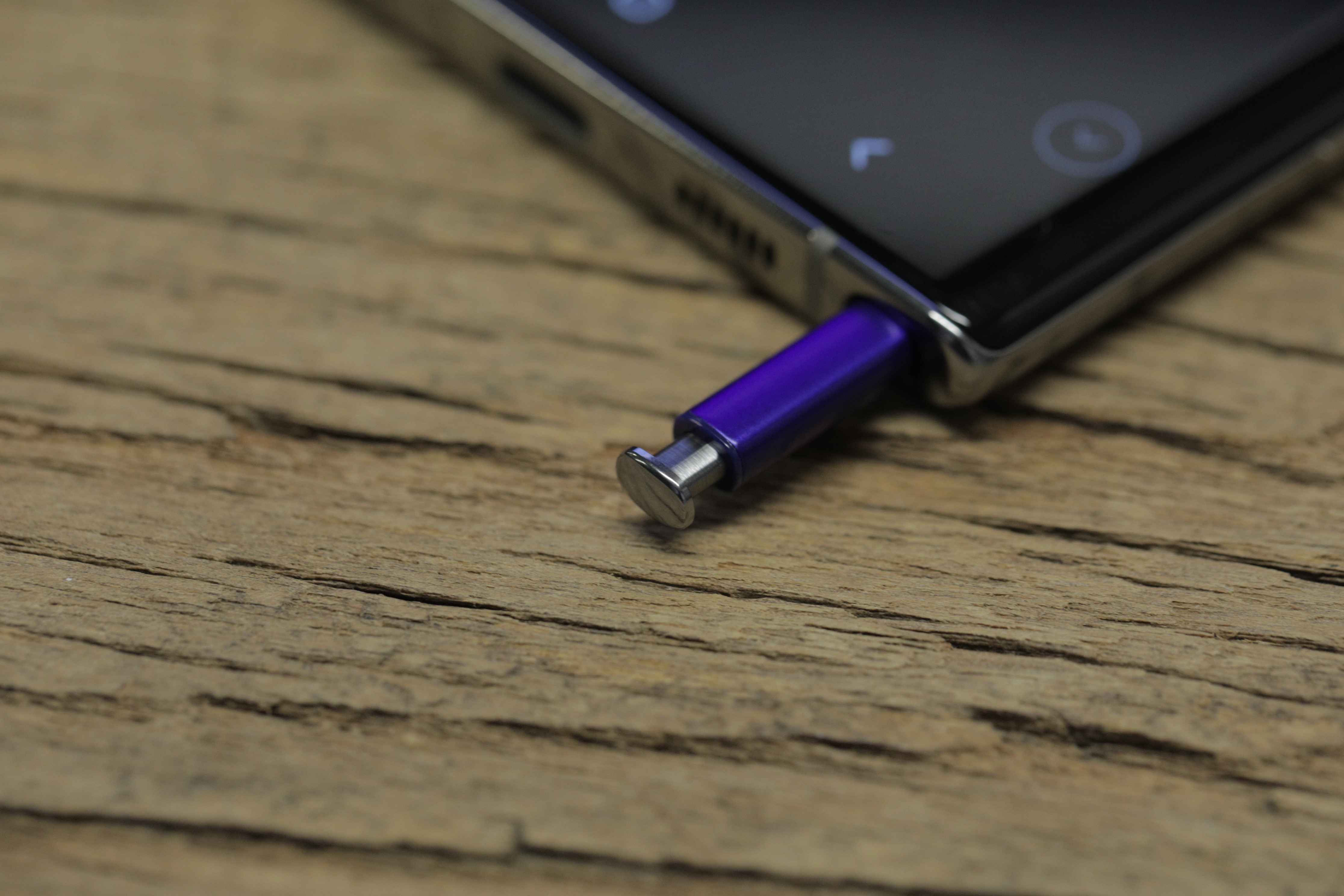
If anything, the Note 10+ feels like the true successor to the Note line. The baseline device could have just as well been labeled the Note 10 Lite. That’s something Samsung is keenly aware of, as it targets first-time Note users with the 10 and true believers with the 10+. In both cases, Samsung is faced with the same task as the rest of the industry: offering a compelling reason for users to upgrade.
Earlier this week, a Note 9 owner asked me whether the new device warrants an upgrade. The answer is, of course, no. The pace of smartphone innovation has slowed, even as prices have risen. Honestly, the 10 doesn’t really offer that many compelling reasons to upgrade from the Note 8.
That’s not a slight against Samsung or the Note, per se. If anything, it’s a reflection on the fact that these phones are quite good — and have been for a while. Anecdotally, industry excitement around these devices has been tapering for a while now, and the device’s launch in the midst of the doldrums of August likely didn’t help much.
The past few years have seen smartphones transform from coveted, bleeding-edge luxury to necessity. The good news to that end, however, is that the Note continues to be among the best devices out there.
The common refrain in the earliest days of the phablet was the inability to wrap one’s fingers around the device. It’s a pragmatic issue. Certainly you don’t want to use a phone day to day that’s impossible to hold. But Samsung’s remarkable job of improving screen to body ratio continues here. In fact, the 6.8-inch Note 10+ has roughly the same footprint as the 6.4-inch Note 9.
The issue will still persist for those with smaller hands — though thankfully Samsung’s got a solution for them in the Note 10. For the rest of us, the Note 10+ is easily held in one hand and slipped in and out of pants pockets. I realize these seem like weird things to say at this point, but I assure you they were legitimate concerns in the earliest days of the phablet, when these things were giant hunks of plastic and glass.
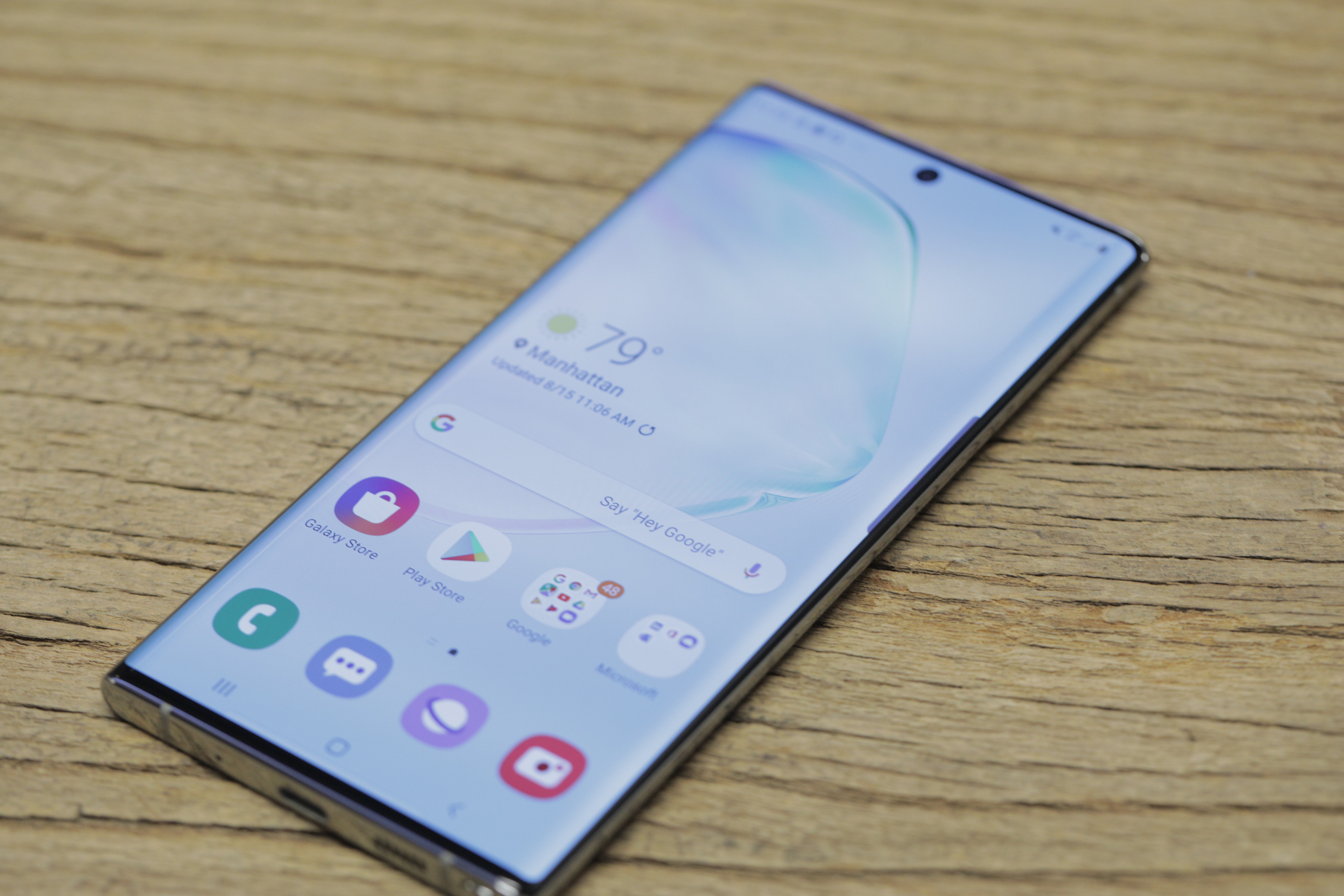
Samsung’s curved display once again does much of the heavy lifting here, allowing the screen to stretch nearly from side to side with only a little bezel at the edge. Up top is a hole-punch camera — that’s “Infinity O” to you. Those with keen eyes no doubt immediately noticed that Samsung has dropped the dual selfie camera here, moving toward the more popular hole-punch camera.
The company’s reasoning for this was both aesthetic and, apparently, practical. The company moved back down to a single camera for the front (10 megapixel), using similar reasoning as Google’s single rear-facing camera on the Pixel: software has greatly improved what companies can do with a single lens. That’s certainly the case to a degree, and a strong case can be made for the selfie camera, which we generally require less of than the rear-facing array.
The company’s gone increasingly minimalist with the design language — something I appreciate. Over the years, as the smartphone has increasingly become a day to day utility, the product’s design has increasingly gotten out of its own way. The front and back are both made of a curved Gorilla Glass that butts up against a thin metal form with a total thickness of 7.9 millimeters.
On certain smooth surfaces like glass, you’ll occasionally find the device gliding slightly. I’d say the chances of dropping it are pretty decent with its frictionless design language, so you’re going to want to get a case for your $1,000 phone. Before you do, admire that color scheme on the back. There are four choices in all. Like the rest of the press, we ended up with Aura Glow.
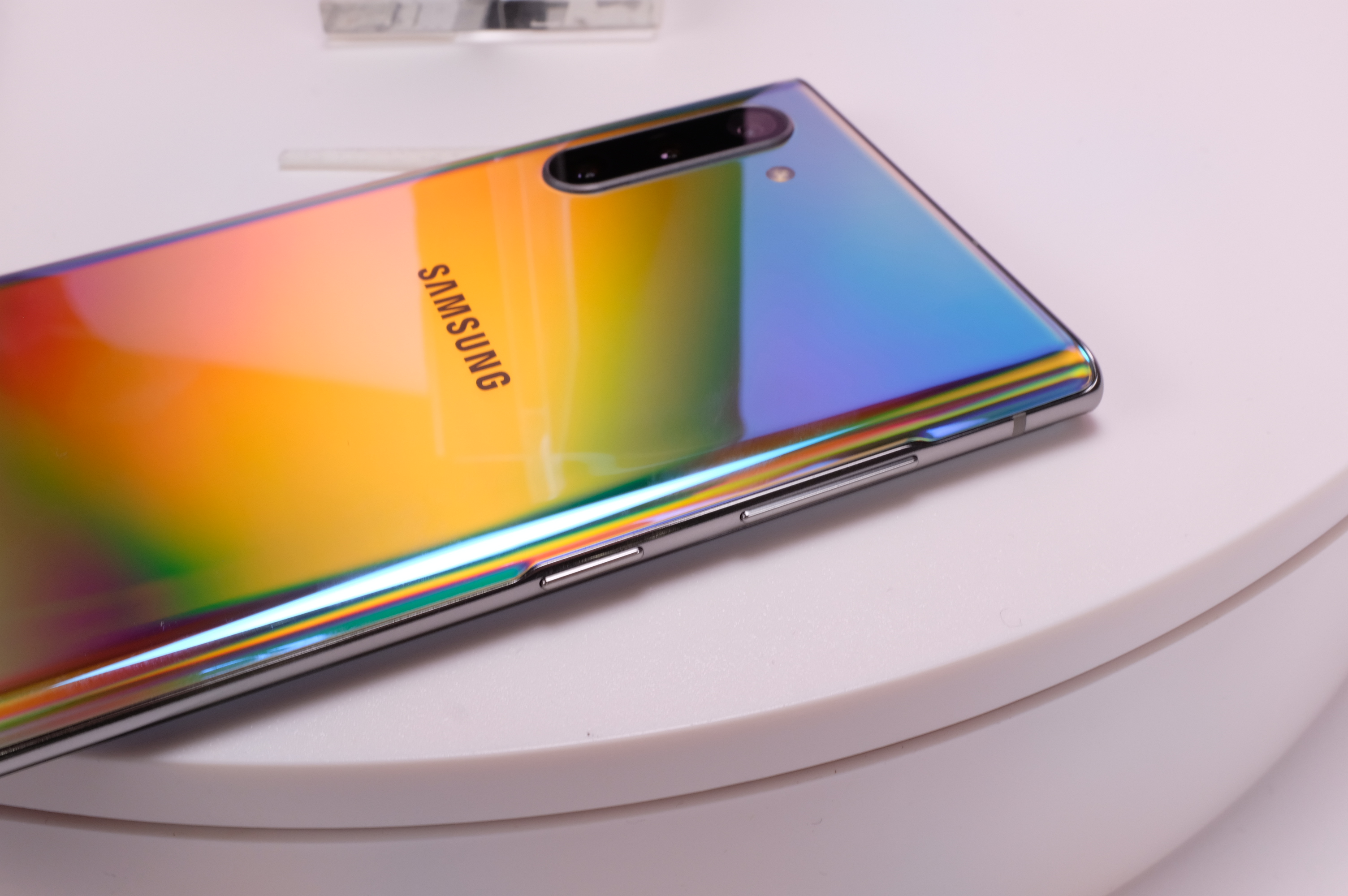
It features a lovely, prismatic effect when light hits it. It’s proven a bit tricky to photograph, honestly. It’s also a fingerprint magnet, but these are the prices we pay to have the prettiest phone on the block.
One of the interesting footnotes here is how much the design of the 10 will be defined by what the device lost. There are two missing pieces here — both of which are a kind of concession from Samsung for different reasons. And for different reasons, both feel inevitable.
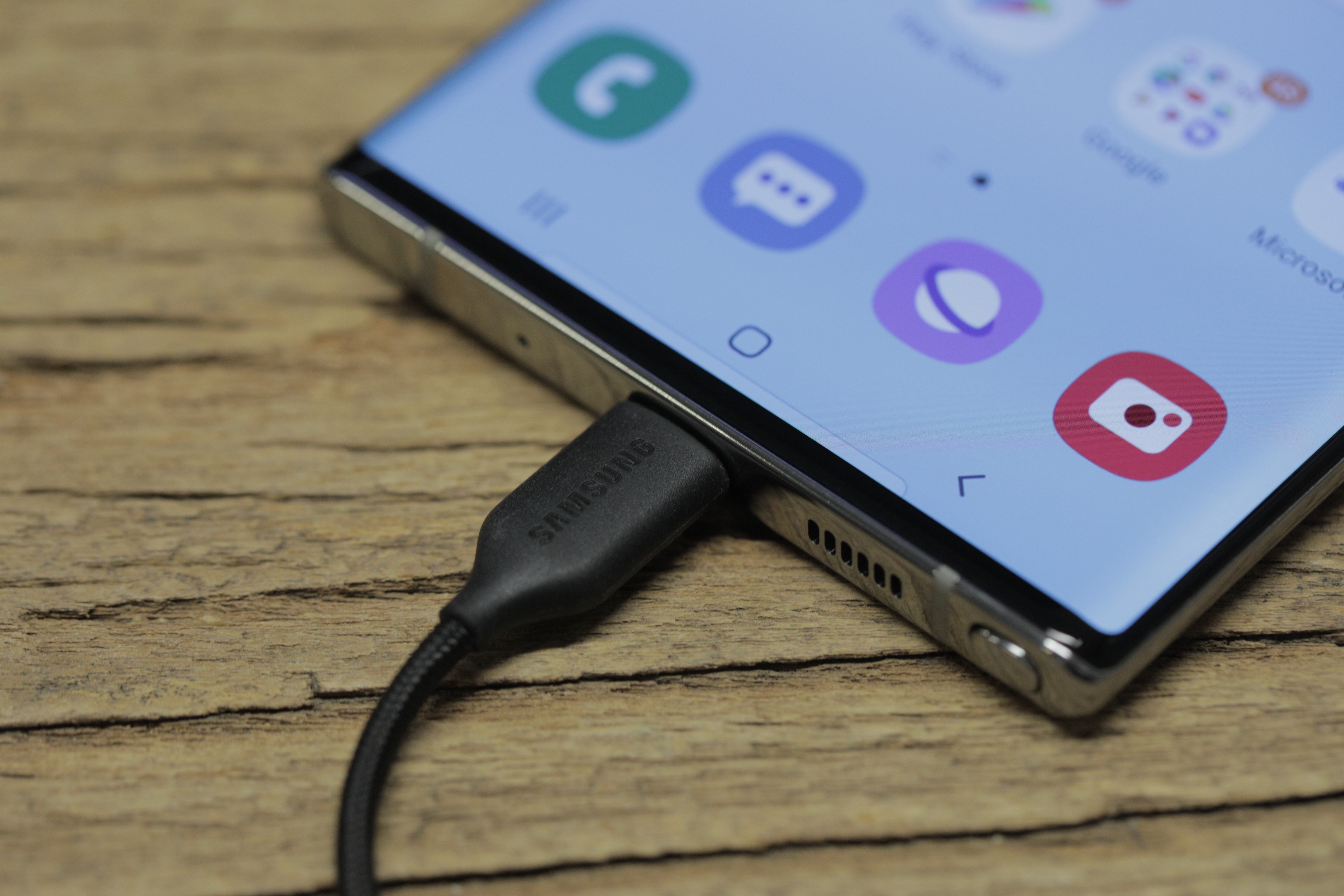
The headphone jack is, of course, the biggie. Samsung kicked and screamed on that one, holding onto the 3.5mm with dear life and roundly mocking the competition (read: Apple) at every turn. The company must have known it was a matter of time, even before the iPhone dropped the port three years ago.
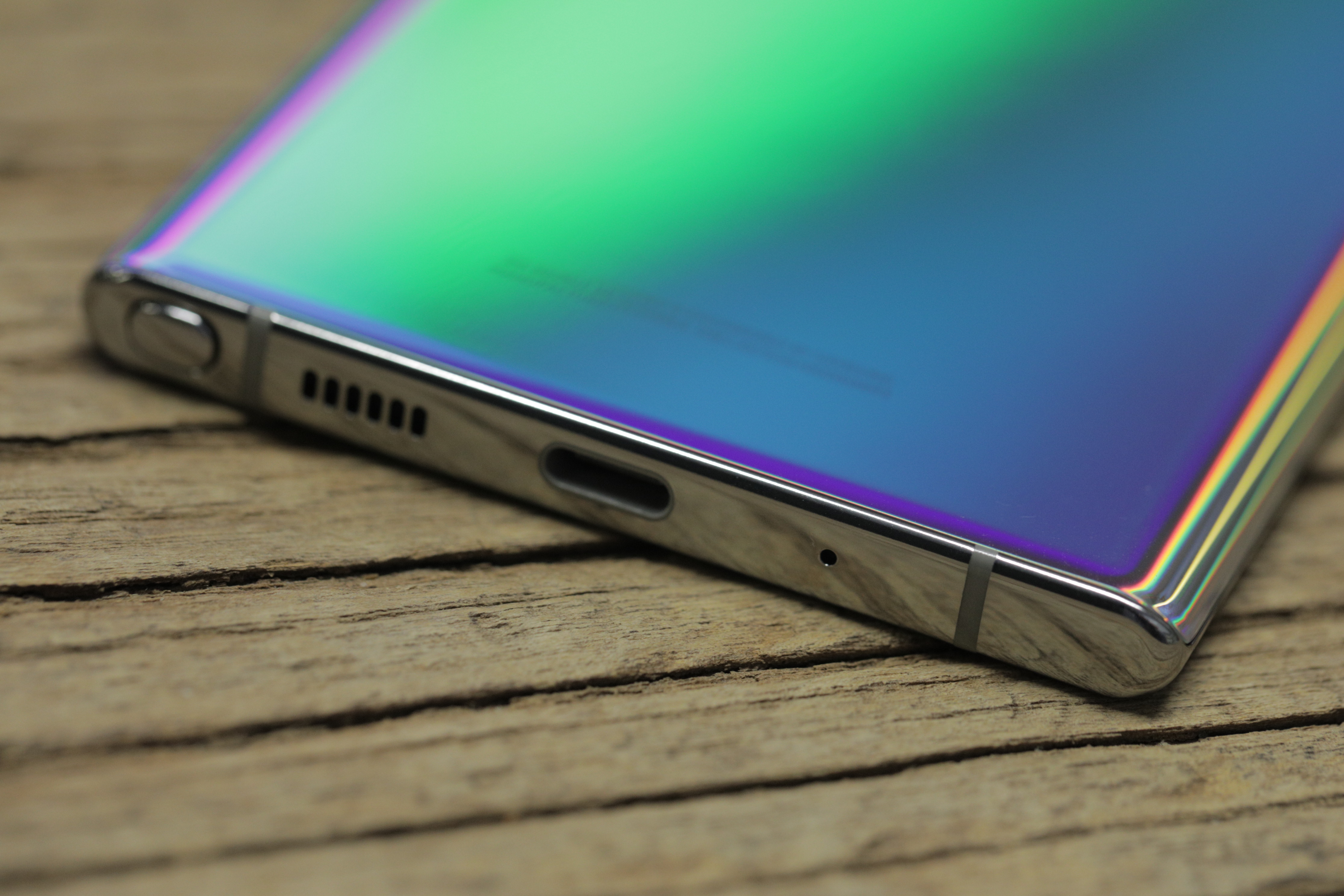
Samsung glossed over the end of the jack (and apparently unlisted its Apple-mocking ads in the process) during the Note’s launch event. It was a stark contrast from a briefing we got around the device’s announcement, where the company’s reps spent significantly more time justifying the move. They know us well enough to know that we’d spend a little time taking the piss out of the company after three years of it making the once ubiquitous port a feature. All’s fair in love and port. And honestly, it was mostly just some good-natured ribbing. Welcome to the club, Samsung.
As for why Samsung did it now, the answer seems to be two-fold. The first is a kind of critical mass in Bluetooth headset usage. Allow me to quote myself from a few weeks back:
The tipping point, it says, came when its internal metrics showed that a majority of users on its flagship devices (the S and Note lines) moved to Bluetooth streaming. The company says the number is now in excess of 70% of users.
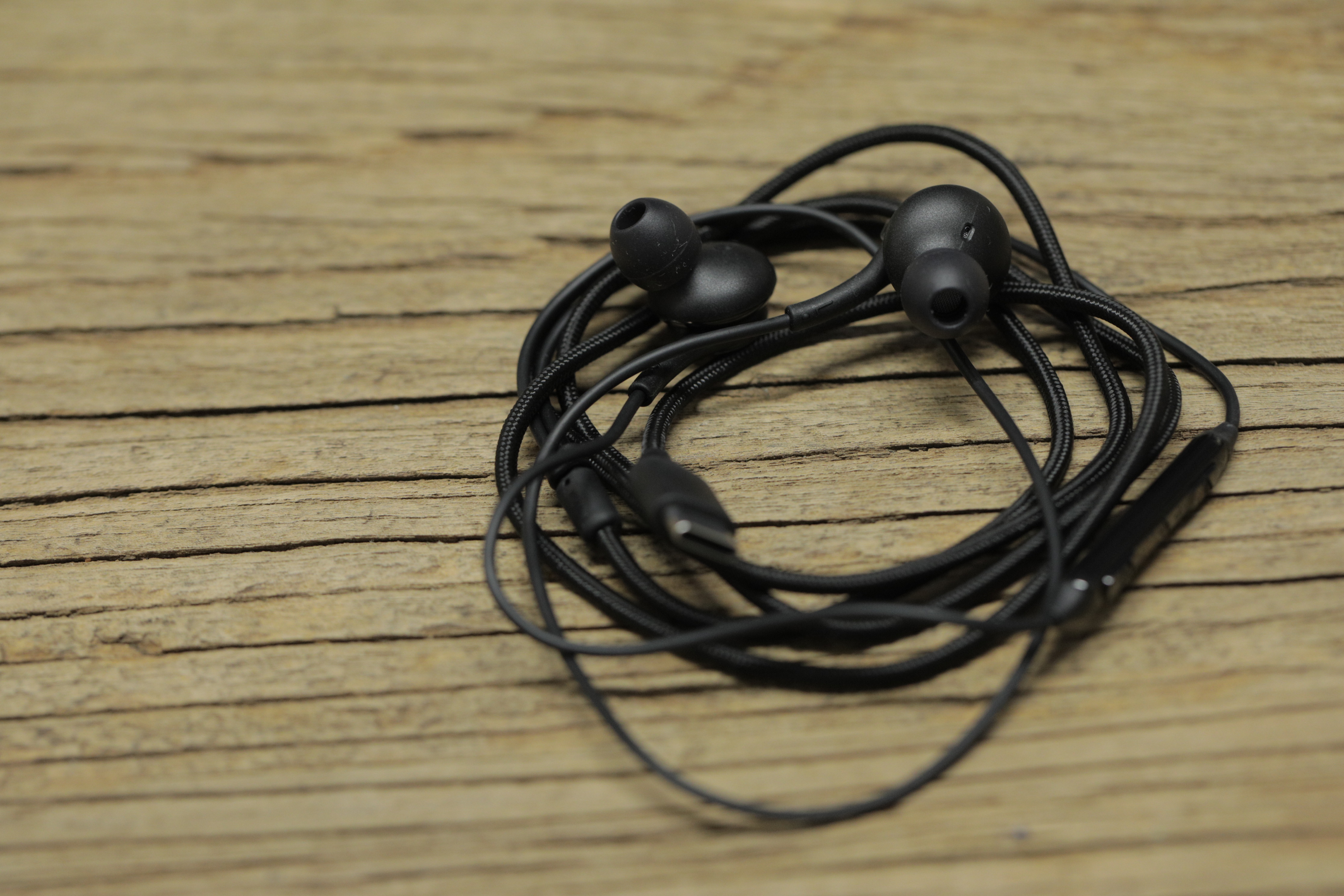
Also, as we’re all abundantly aware, the company put its big battery ambitions on hold for a bit, as it dealt with…more burning problems. A couple of recalls, a humble press release and an eight-point battery check later, and batteries are getting bigger again. There’s a 3,500mAh on the Note 10 and a 4,300mAh on the 10+. I’m happy to report that the latter got me through a full day plus three hours on a charge. Not bad, given all of the music and videos I subjected it to in that time.
There’s no USB-C dongle in-box. The rumors got that one wrong. You can pick up a Samsung-branded adapter for $15, or get one for much cheaper elsewhere. There is, however, a pair of AKG USB-C headphones in-box. I’ve said this before and I’ll say it again: Samsung doesn’t get enough credit for its free headphones. I’ve been known to use the pairs with other devices. They’re not the greatest the world, but they’re better sounding and more comfortable than what a lot of other companies offer in-box.
Obviously the standard no headphone jack things apply here. You can’t use the wired headphones and charge at the same time (unless you go wireless). You know the deal.
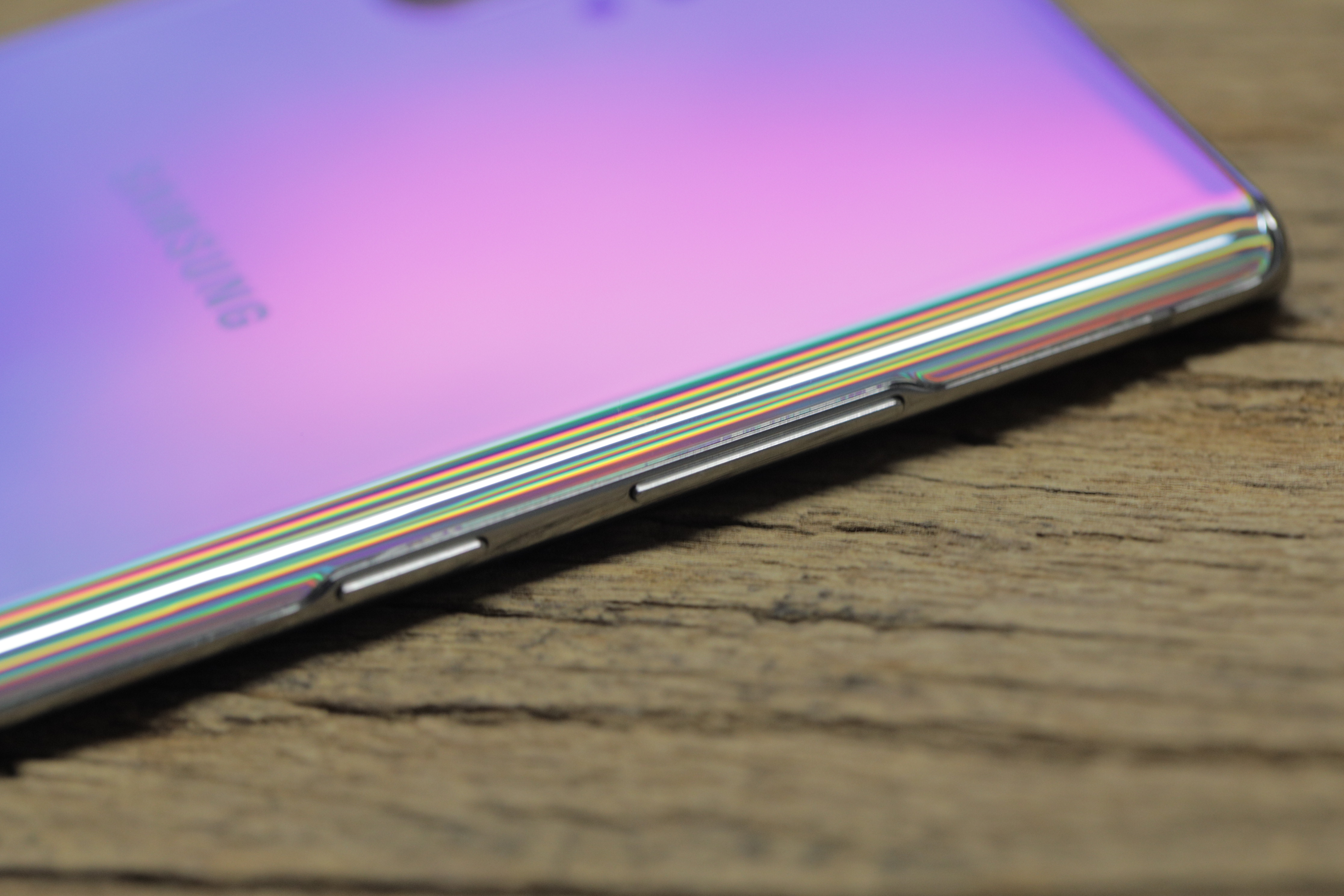
The other missing piece here is the Bixby button. I’m sure there are a handful of folks out there who will bemoan its loss, but that’s almost certainly a minority of the minority here. Since the button was first introduced, folks were asking for the ability to remap it. Samsung finally relented on that front, and with the Note 10, it drops the button altogether.
Thus far the smart assistant has been a disappointment. That’s due in no small part to a late launch compared to the likes of Siri, Alexa and Assistant, coupled with a general lack of capability at launch. In Samsung’s defense, the company’s been working to fix that with some pretty massive investment and a big push to court developers. There’s hope for Bixby yet, but a majority of users weren’t eager to have the assistant thrust upon them.
Instead, the power button has been shifted to the left of the device, just under the volume rocker. I preferred having it on the other side, especially for certain functions like screenshotting (something, granted, I do much more than the average user when reviewing a phone). That’s a pretty small quibble, of course.
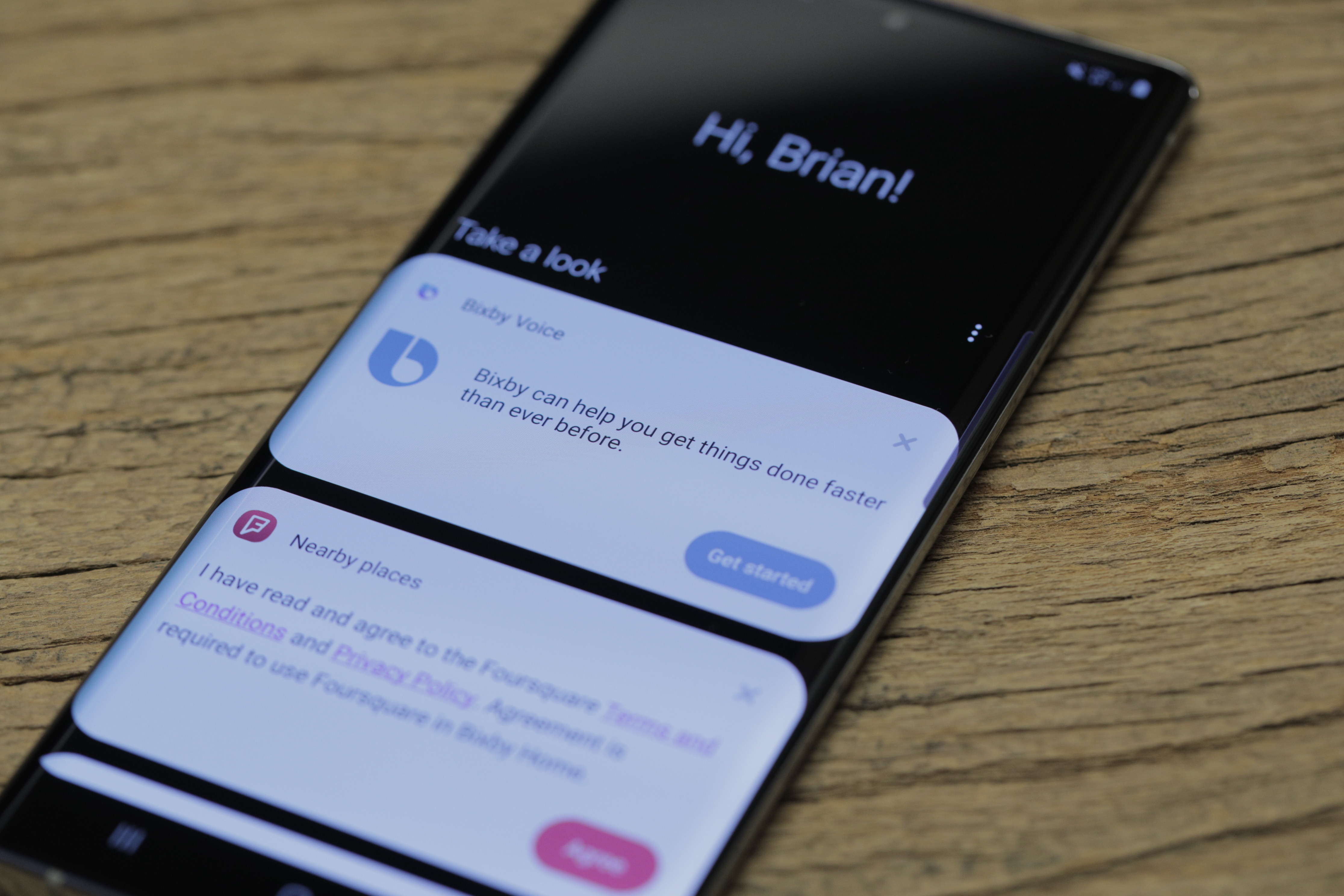
Bixby can now be quickly accessed by holding down the power button. Handily, Samsung still lets you reassign the function there, if you really want Bixby out of your life. You can also hold down to get the power off menu or double press to launch Bixby or a third-party app (I opted for Spotify, probably my most used these days), though not a different assistant.
Imaging, meanwhile, is something Samsung’s been doing for a long time. The past several generations of S and Note devices have had great camera systems, and it continues to be the main point of improvement. It’s also one of few points of distinction between the 10 and 10+, aside from size.
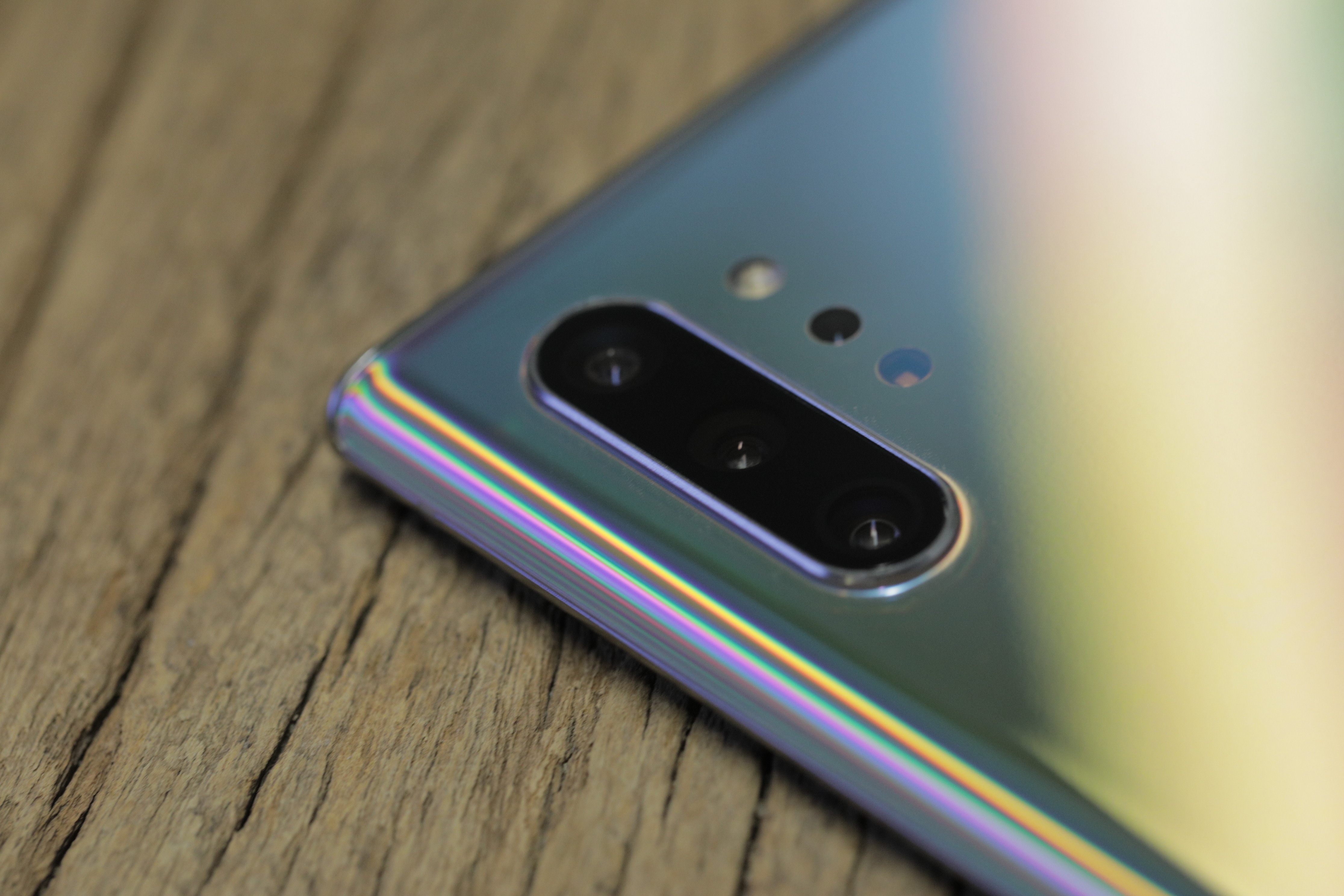
The Note 10+ has four, count ’em, four rear-facing cameras. They are as follows:
- Ultra Wide: 16 megapixel
- Wide: 12 megapixel
- Telephoto: 12 megapixel
- DepthVision

That last one is only on the plus. It’s comprised of two little circles to the right of the primary camera array and just below the flash. We’ll get to that in a second.

The main camera array continues to be one of the best in mobile. The inclusion of telephoto and ultra-wide lenses allow for a wide range of different shots, and the hardware coupled with machine learning makes it a lot more difficult to take a bad photo (though believe me, it’s still possible).
The live focus feature (Portrait mode, essentially) comes to video, with four different filters, including Color Point, which makes everything but the subject black and white.
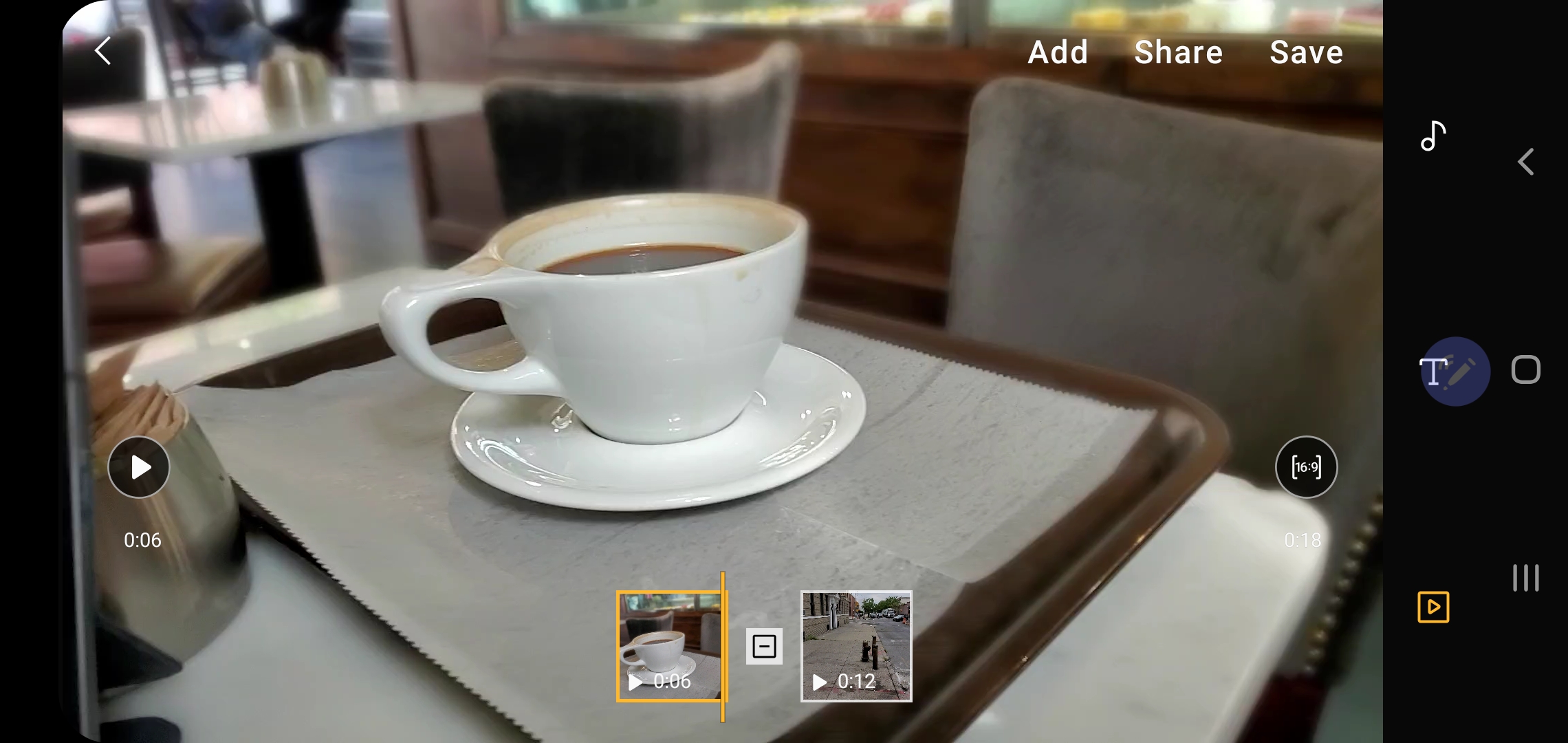
Samsung’s also brought a very simple video editor into the mix here, which is nice on the fly. You can edit the length of clips, splice in other clips, add subtitles and captions and add filters and music. It’s pretty beefy for something baked directly into the camera app, and one of the better uses I’ve found for the S Pen.
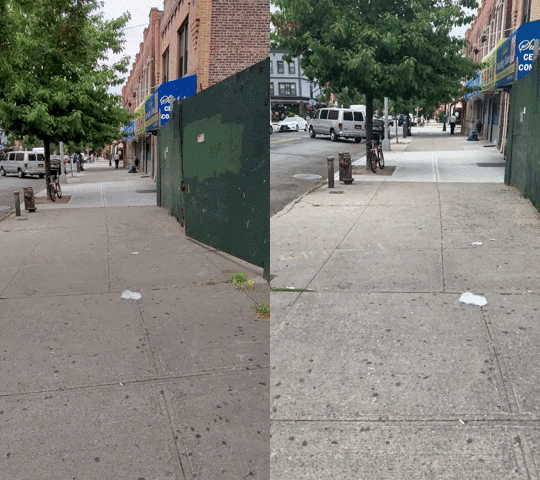
Note 10+ with Super Steady (left), iPhone XS (right)
Ditto for the improved Super Steady offering, which smooths out shaky video, including Hyperlapse mode, where handshakes are a big issue. It works well, but you do lose access to other features, including zoom. For that reason, it’s off by default and should be used relatively sparingly.

Note 10+ (left), iPhone XS (right)
Zoom-on Mic is a clever addition, as well. While shooting video, pinch-zooming on something will amplify the noise from that area. I’ve been playing around with it in this cafe. It’s interesting, but less than perfect.
Zooming into something doesn’t exactly cancel out ambient noise from outside of the frame. Everything still gets amplified in the process and, like digital picture zoom, a lot of noise gets added in the process. Those hoping for a kind of spy microphone, I’m sorry/happy to report that this definitely is not that.
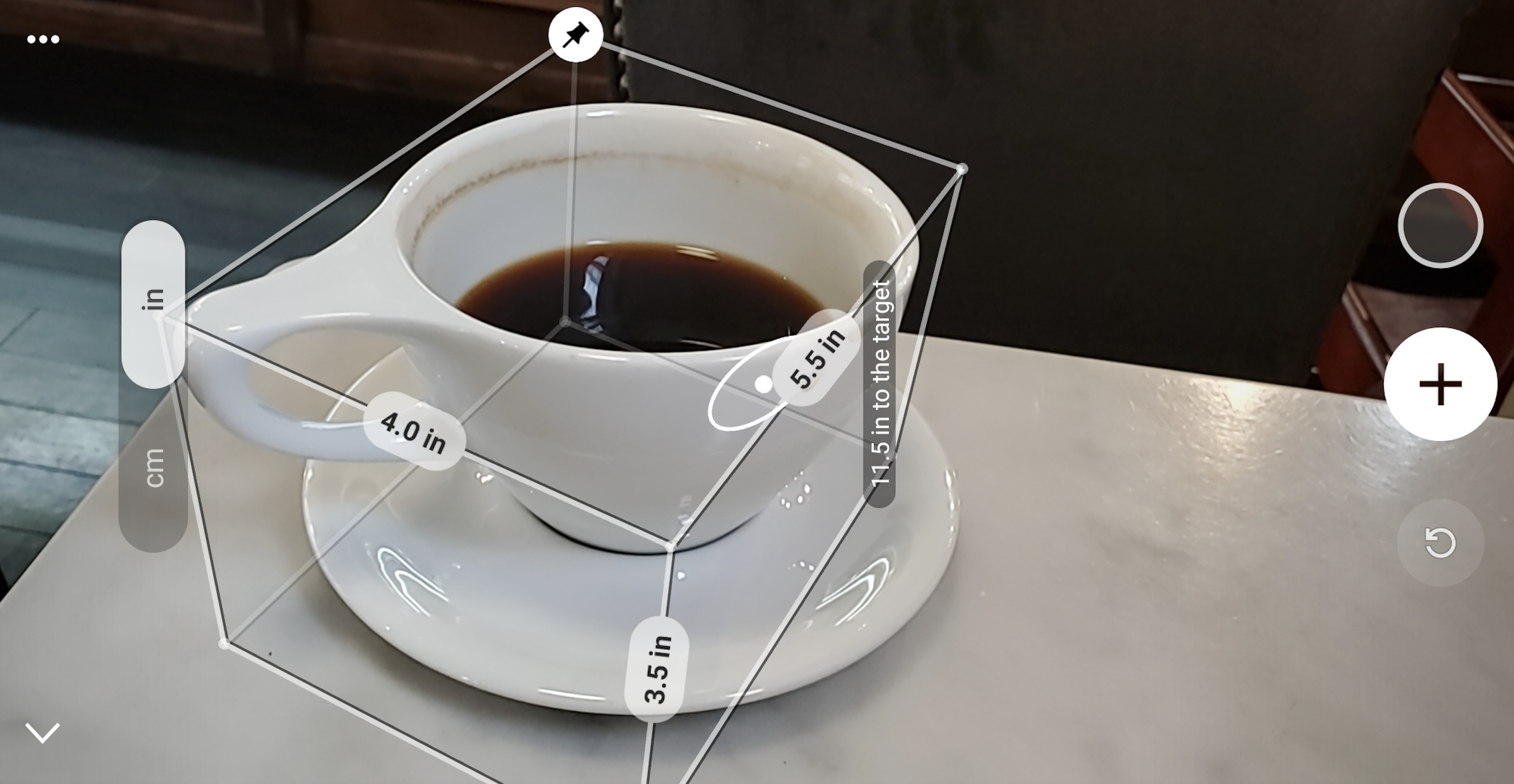
The DepthVision Camera is also pretty limited as I write this. If anything, it’s Samsung’s attempt to brace for a future when things like augmented reality will (theoretically) play a much larger role in our mobile computing. In a conversation I had with the company ahead of launch, they suggested that a lot of the camera’s AR functions will fall in the hands of developers.
For now, Quick Measure is the one practical use. The app is a lot like Apple’s more simply titled Measure. Fire it up, move the camera around to get a lay of the land and it will measure nearby objects for you. An interesting showcase for AR potential? Sure. Earth shattering? Naw. It also seems to be a bit of a battery drain, sucking up the last few bits of juice as I was running it down.
3D Scanner, on the other hand, got by far the biggest applause line of the Note event. And, indeed, it’s impressive. In the stage demo, a Samsung employee scanned a stuffed pink beaver (I’m not making this up), created a 3D image and animated it using an associate’ movements. Practical? Not really. Cool? Definitely.
It was, however, not available at press time. Hopefully it proves to be more than vaporware, especially if that demo helped push some viewers over to the 10+. Without it, there’s just not a lot of use for the depth camera at the moment.
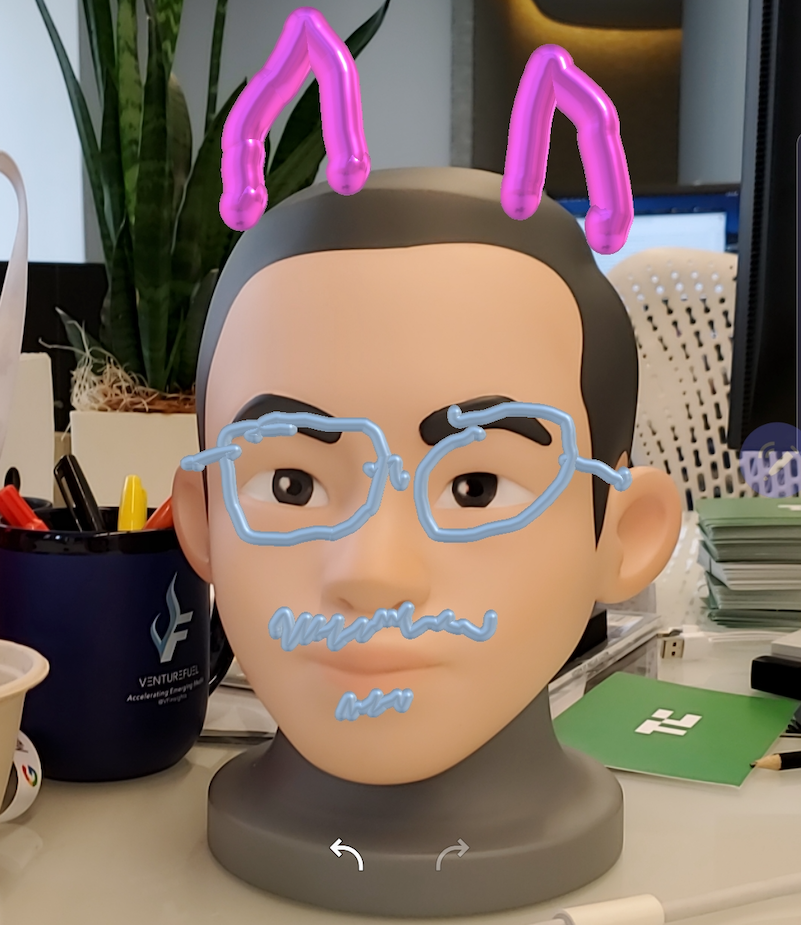
There’s also AR Doodle, which fills a similar spot as much of the company’s AR offerings. It’s kind of fun, but again, not particularly useful. You’ll likely end up playing with it for a few minutes and forget about it entirely. Such is life.
The feature is built into the camera app, using depth sensing to orient live drawings. With the stylus you can draw in space or doodle on people’s faces. It’s neat, the AR works okay and I was bored with it in about three minutes. Like Quick Measure, the feature is as much a proof of concept as anything. But that’s always been a part of Samsung’s kitchen-sink approach — some combination of useful and silly.

That said, points to Samsung for continuing to de-creepify AR Emojis. Those have moved firmly away from the uncanny valley into something more cartoony/adorable. Less ironic usage will surely follow.
Asked about the key differences between the S and Note lines, Samsung’s response was simple: the S Pen. Otherwise, the lines are relatively interchangeable.
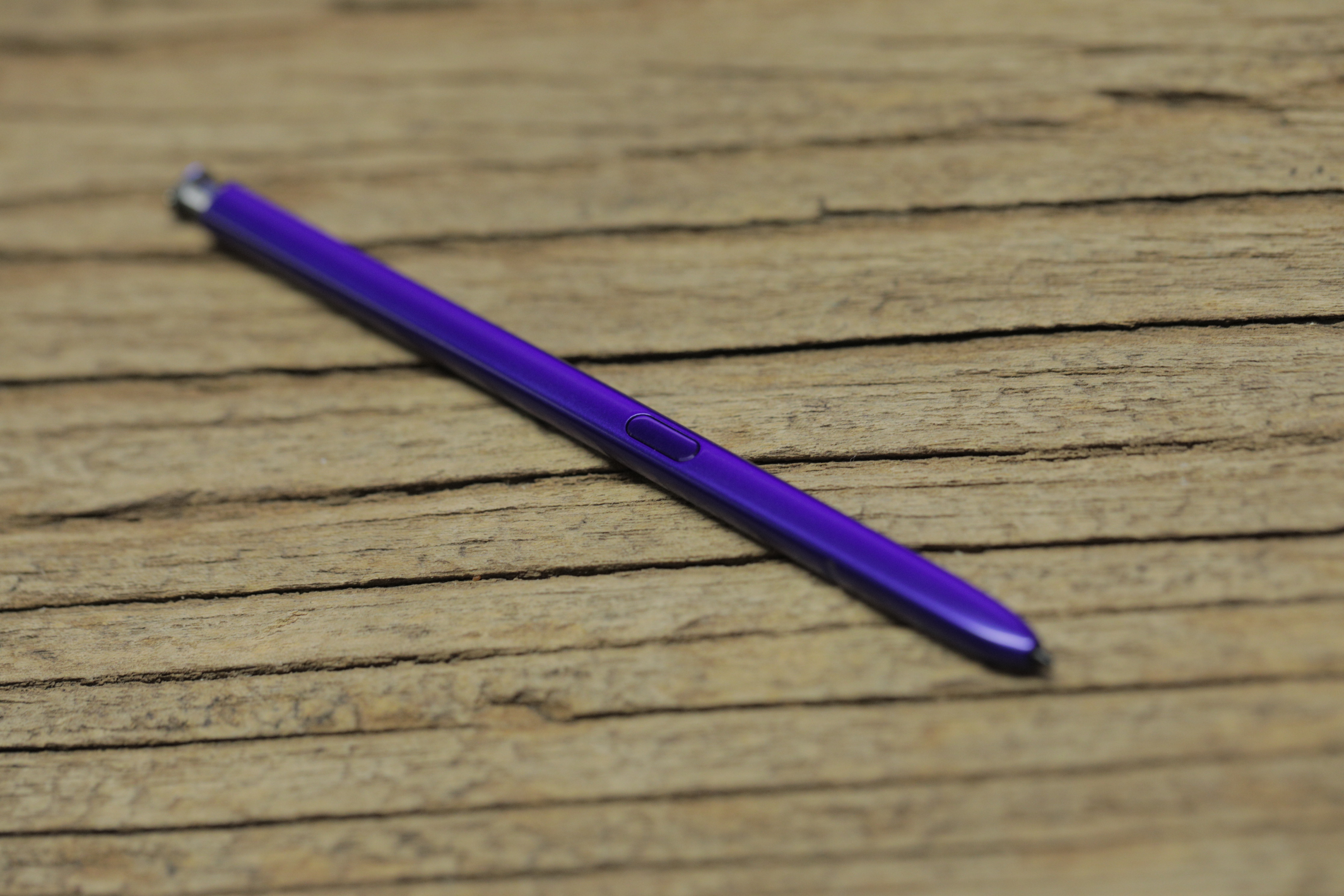
Samsung’s return of the stylus didn’t catch on for handsets quite like the phablet form factor. They’ve made a pretty significant comeback for tablets, but the Note remains fairly singular when it comes to the S Pen. I’ve never been a big user myself, but those who like it swear by it. It’s one of those things like the ThinkPad pointing stick or BlackBerry scroll wheel.
Like the phone itself, the peripheral has been streamlined with a unibody design. Samsung also continues to add capabilities. It can be used to control music, advance slideshows and snap photos. None of that is likely to convince S Pen skeptics (I prefer using the buttons on the included headphones for music control, for example), but more versatility is generally a good thing.
If anything is going to convince people to pick up the S Pen this time out, it’s the improved handwriting recognition. That’s pretty impressive. It was even able to decipher my awful chicken scratch.
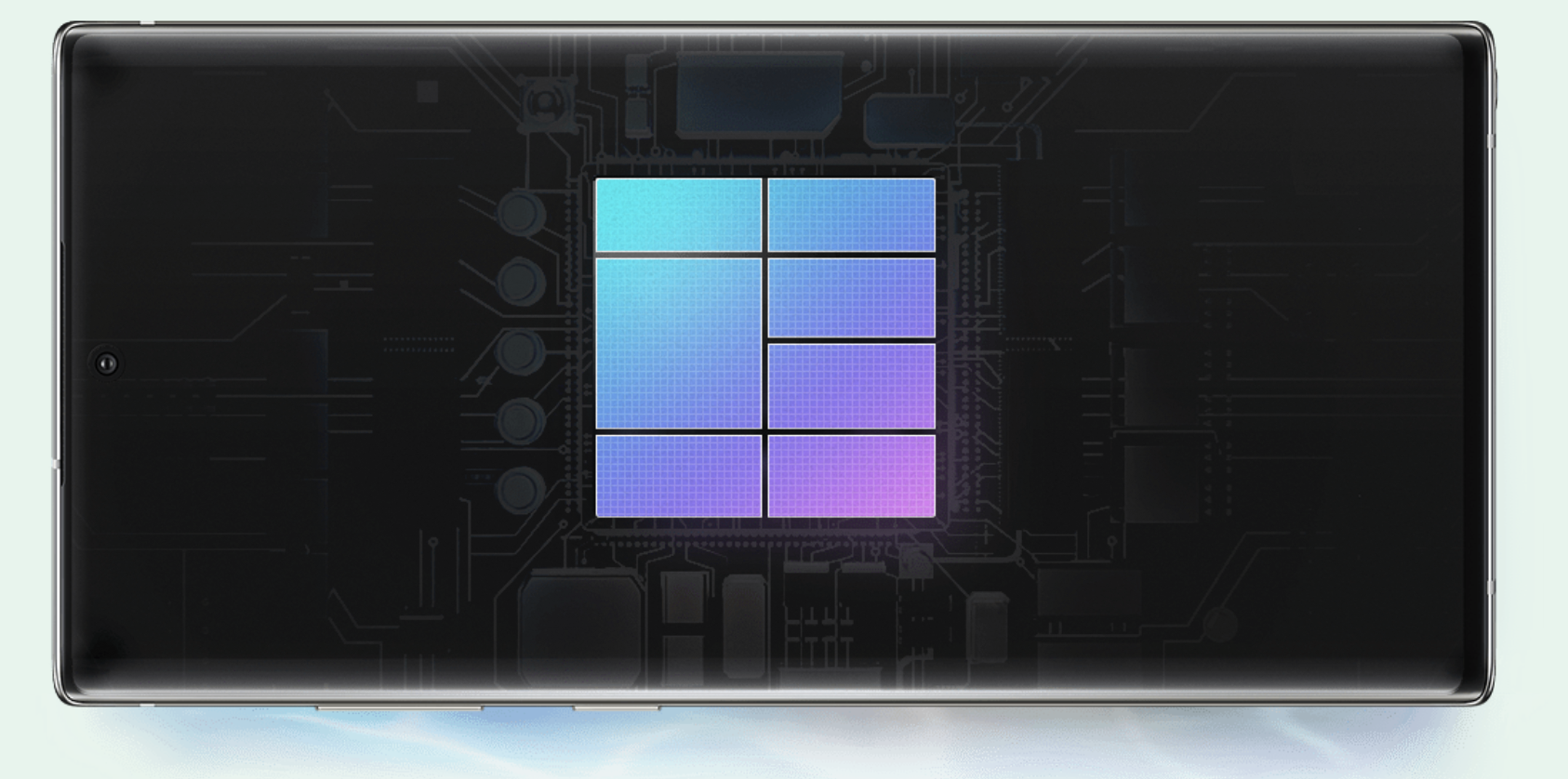
You get the same sort of bleeding-edge specs here you’ve come to expect from Samsung’s flagships. The 10+ gets you a baseline 256GB of storage (upgradable to 512), coupled with a beefy 12GB of RAM (the regular Note is a still good 8GB/256GB). The 5G version sports the same numbers and battery (likely making its total life a bit shorter per charge). That’s a shift from the S10, whose 5G version was specced out like crazy. Likely Samsung is bracing for 5G to become less of a novelty in the next year or so.
The new Note also benefits from other recent additions, like the in-display fingerprint reader and wireless power sharing. Both are nice additions, but neither is likely enough to warrant an immediate upgrade.
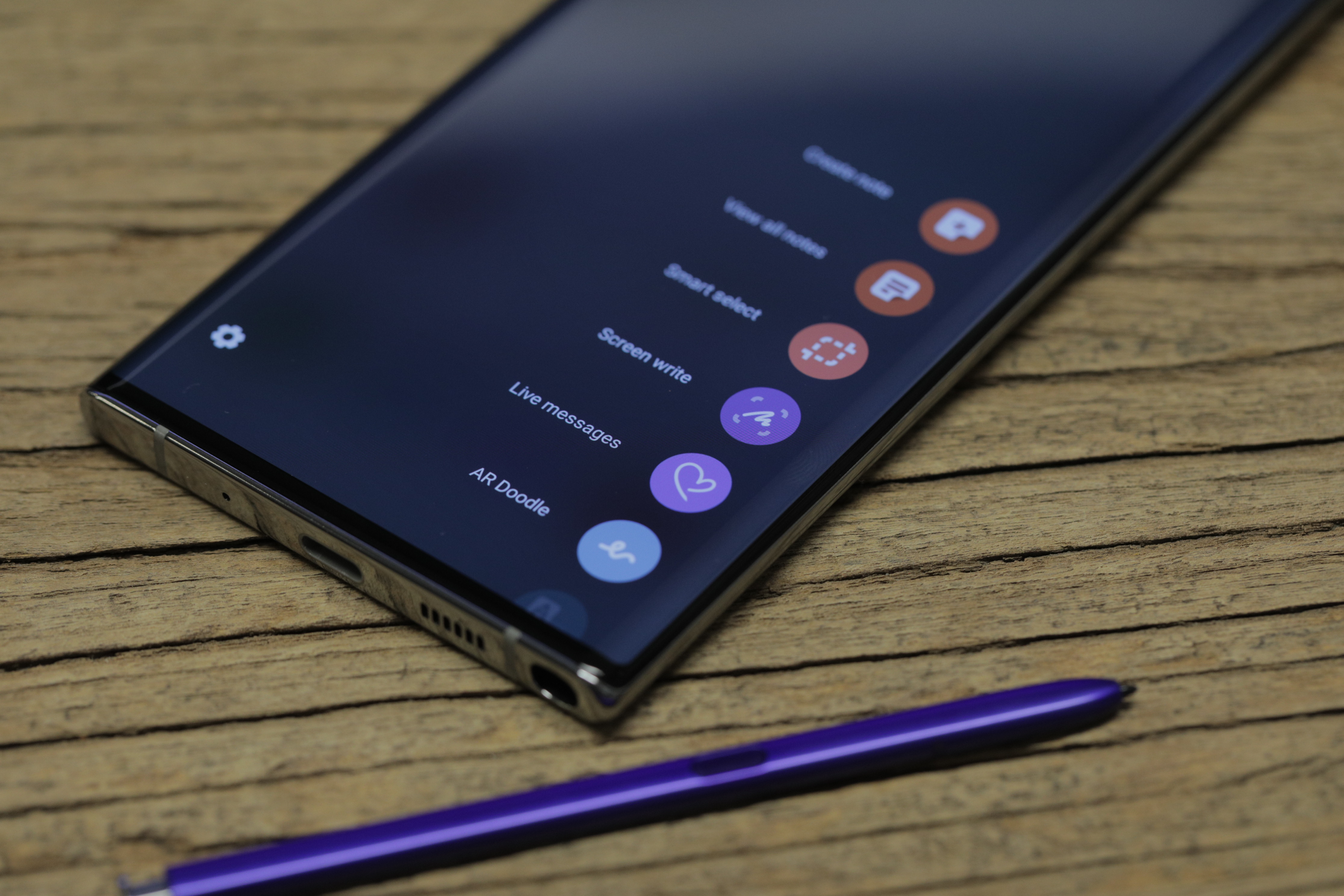
Once again, that’s not an indictment of Samsung, so much as a reflection of where we are in the life cycle of a mature smartphone industry. The Note 10+ is another good addition to one of the leading smartphone lines. It succeeds as both a productivity device (thanks to additions like DeX and added cross-platform functionality with Windows 10) and an everyday handset.
There’s not enough on-board to really recommend an upgrade from the Note 8 or 9 — especially at that $1,099 price. People are holding onto their devices for longer, and for good reason (as detailed above). But if you need a new phone, are looking for something big and flashy and are willing to splurge, the Note continues to be the one to beat.
Powered by WPeMatico
ClearBrain launches analytics tools focused on connecting cause and effect
Businesses need to understand cause and effect: Someone did X and it increased sales, or they did Y and it hurt sales. That’s why many of them turn to analytics — but Bilal Mahmood, co-founder and CEO of ClearBrain, said existing analytics platforms can’t answer that question accurately.
“Every analytics platform today is still based on a fundamental correlation model,” Mahmood said. It’s the classic correlation-versus-causation problem — you can use the data to suggest that an action and a result are related, but you can’t draw a direct cause-and-effect relationship.
That’s the problem that ClearBrain is trying to solve with its new “causal analytics” tool. As the company put it in a blog post, “Our goal was to automate this process [of running statistical studies] and build the first large-scale causal inference engine to allow growth teams to measure the causal effect of every action.”
You can read the post for (many) more details, but the gist is that Mahmood and his team claim they can draw accurate causal relationships where others can’t.
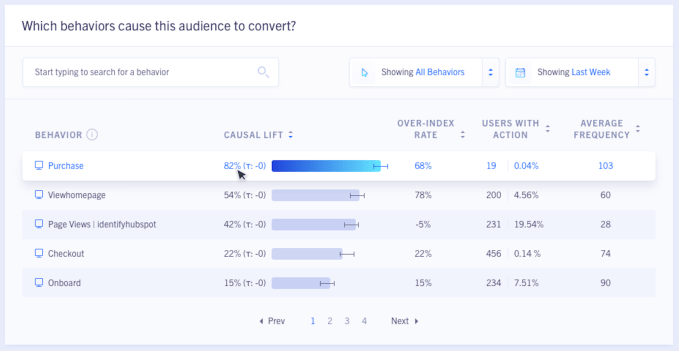
The idea is to use this in conjunction with A/B testing — customers look at the data to prioritize what to test next, and to make estimates about the impact of things that can’t be tested. Otherwise, Mahmood said, “If you wanted to measure the actual impact of every variable on your website and your app — the actual impact it has on conversation — it could take you years.”
When I wrote about ClearBrain last year, it was using artificial intelligence to improve ad targeting, but Mahmood said the company built the new analytics technology in response to customer demand: “People didn’t just want to know who was going to convert, they wanted to know why, and what caused them to do so.”
The causal analytics tool is currently available to early access users, with plans for a full launch in October. Mahmood said there will be a number of pricing tiers, but they’ll be structured to make the product free for many startups.
In addition to launching the analytics tool in early access, ClearBrain also announced this week that it’s raised an additional $2 million in funding from Harrison Metal and Menlo Ventures.
Powered by WPeMatico

